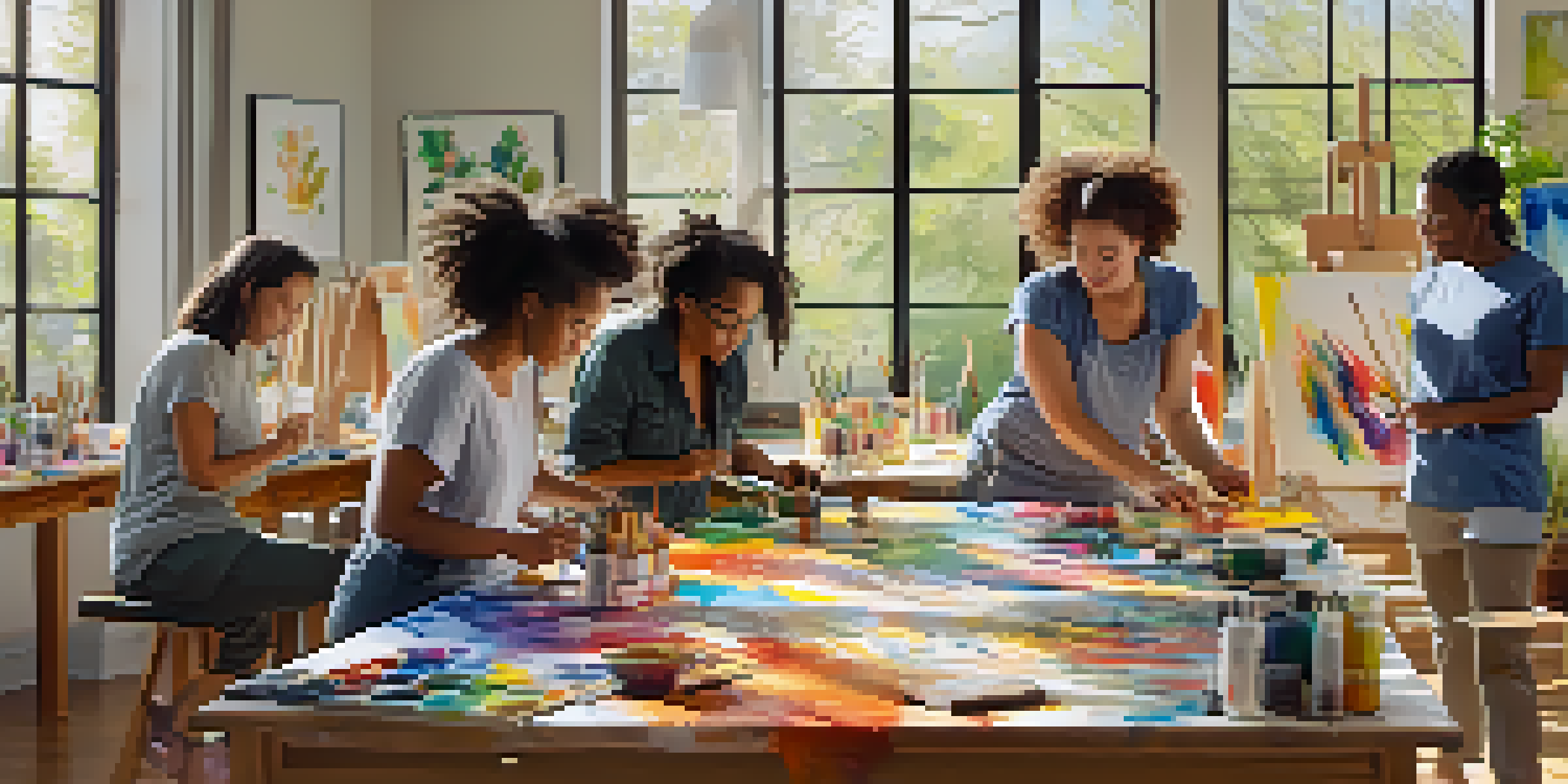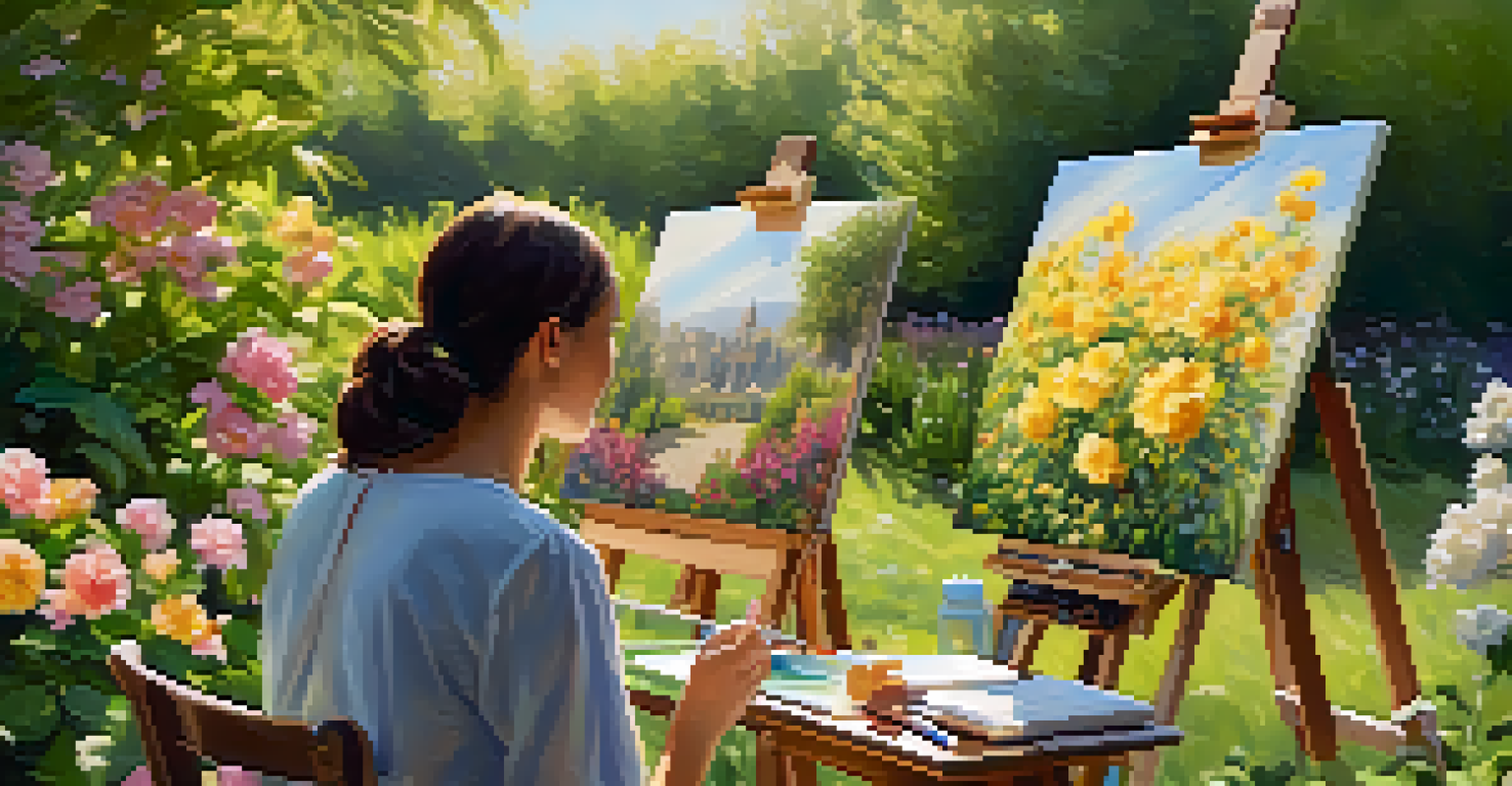The Intersection of Marijuana Use and Art Therapy Techniques

Understanding Art Therapy and Its Benefits
Art therapy is a therapeutic practice that uses creative expression to help individuals process emotions and experiences. It allows people to explore their feelings through various art forms, such as painting, drawing, or sculpting. This non-verbal approach can be particularly beneficial for those who find it difficult to articulate their emotions verbally.
Art is not what you see, but what you make others see.
The benefits of art therapy are vast, including reduced anxiety, improved self-esteem, and increased emotional resilience. It offers a safe space for individuals to experiment and express themselves without the fear of judgment. For many, the act of creating art can be a powerful catalyst for healing.
Moreover, art therapy is often used in conjunction with other therapeutic techniques, enhancing its effectiveness. It can serve as a bridge to deeper emotional exploration, helping individuals gain insights into their thoughts and feelings.
The Role of Marijuana in Creative Expression
Marijuana has long been associated with creative expression, with many artists and musicians citing it as a source of inspiration. The psychoactive properties of cannabis can alter perception and enhance sensory experiences, potentially leading to a more profound creative process. For some, it lowers inhibitions and encourages risk-taking in artistic endeavors.

However, the relationship between marijuana and creativity is complex. While some may experience heightened creativity, others might find that it disrupts their focus or motivation. It’s essential to understand that the effects of marijuana can vary significantly from person to person, often influenced by individual tolerance and the specific strain used.
Art Therapy Enhances Emotional Healing
Art therapy provides a creative outlet for individuals to express and process their emotions, leading to reduced anxiety and improved self-esteem.
Ultimately, for those who find it helpful, marijuana can serve as a tool to unlock new ideas and perspectives in their art. This intersection of marijuana use and creativity opens up exciting discussions about the nature of inspiration and artistic expression.
Therapeutic Benefits of Combining Marijuana and Art Therapy
When combined, marijuana and art therapy can create a unique therapeutic environment. The calming effects of cannabis may help individuals feel more relaxed and open, making them more receptive to exploring their emotions through art. This synergy can enhance the overall therapeutic experience, leading to deeper insights and connections.
The creative adult is the child who survived.
For example, someone struggling with anxiety may find that using marijuana before a therapy session allows them to engage more freely in the creative process. They may express feelings that were previously difficult to confront, leading to breakthroughs in their emotional healing. This combination can transform the way individuals approach their therapy sessions.
Moreover, the use of marijuana in a controlled, therapeutic setting can help demystify its use and promote responsible consumption. It encourages discussions around mental health, creativity, and personal expression, fostering a supportive community among participants.
Considerations for Using Marijuana in Art Therapy
While the combination of marijuana and art therapy can be beneficial, it’s essential to approach it with caution. Not everyone will respond positively to marijuana, and its effects can vary widely. It’s crucial for individuals to assess their personal experiences with cannabis and consider how it might impact their creative process.
Furthermore, working with a trained art therapist who understands the implications of marijuana use can provide guidance and support. They can help individuals navigate their experiences, ensuring that the therapeutic process remains safe and productive. This professional guidance is especially important for those with underlying health conditions or a history of substance abuse.
Marijuana Can Boost Creative Expression
The psychoactive effects of marijuana may enhance creativity for some individuals, making it a potential tool for artistic exploration.
Ultimately, the goal is to enhance the therapeutic experience, not to replace traditional methods. A thoughtful approach to integrating marijuana can lead to meaningful artistic expression and emotional growth.
Cultural Perspectives on Marijuana and Art
Throughout history, various cultures have embraced the relationship between marijuana and art. From ancient civilizations that used cannabis in rituals to modern artists who advocate for its use as a creative aid, the connection runs deep. This cultural acceptance can influence contemporary attitudes toward marijuana in therapeutic settings.
In many communities, marijuana is viewed not just as a recreational substance, but as a tool for creativity and self-expression. Understanding these cultural perspectives can enrich the conversation around art therapy and marijuana use, highlighting the diverse ways individuals approach creativity.
Additionally, recognizing the cultural significance of cannabis can help dismantle stigmas associated with its use in therapy. It paves the way for more open discussions about mental health, creativity, and the potential benefits of combining these elements in therapeutic practices.
Case Studies: Success Stories in Art Therapy
Numerous case studies illustrate the positive outcomes of integrating marijuana into art therapy sessions. For instance, an individual dealing with PTSD found that using cannabis before creating art allowed them to process traumatic memories without feeling overwhelmed. This breakthrough facilitated a deeper connection to their emotions and led to significant healing.
Another case involved a group of artists who participated in a workshop that combined cannabis use with guided art therapy. Participants reported feeling more free to express themselves and discovered new artistic techniques they hadn’t explored before. These shared experiences fostered community and support, enhancing their overall well-being.
Combining Marijuana and Art Therapy
Integrating marijuana into art therapy can create a relaxed environment that fosters deeper emotional insights and connections.
These success stories highlight the potential of combining marijuana with art therapy, showcasing the transformative power of creativity and self-expression. Such examples can inspire others to explore similar paths towards healing and artistic exploration.
Looking Ahead: Future Research and Practices
As the conversation around marijuana and mental health evolves, so too does the need for more research into its role in art therapy. Future studies can provide valuable insights into how cannabis affects creativity and emotional processing in therapeutic settings. This research will help establish best practices for integrating marijuana into art therapy effectively.
Additionally, as more states and countries consider legalizing cannabis, the accessibility of these combined therapies may grow. This shift could lead to innovative therapeutic approaches that cater to diverse populations, enhancing the mental health landscape. It’s an exciting time to explore the possibilities that lie at the intersection of marijuana and art.

Ultimately, a continued focus on research and open dialogue will pave the way for responsible and effective integration of marijuana into therapeutic practices. As we learn more, we can better support individuals in their healing journeys through creativity.